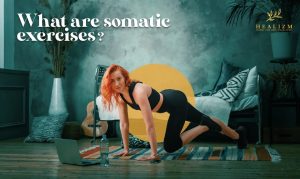
Somatic exercises are body movements that focus on the internal physical perception and experience.
They intend to increase awareness of how we feel inside, both physically and emotionally.
In this post, we will discuss what are somatic exercises in more detail and how to use them in our daily lives.
Through these kinds of exercises, we can learn to pay close attention to what our bodies are trying to tell us.
Practicing somatic exercises can help your body and mind work better.
Doing mind-body exercises daily can help manage conditions like anxiety and depression.
Additionally, if you are seeking a mental Health professional, you may reach out to Healizm.
What Is Somatic Exercise?
Somatic exercise – a holistic route to wellness – is guided by the concept of internal physical sensation.
These exercises place emphasis on the awareness and control of one’s own body.
They work to improve flexibility and muscle engagement, while also encouraging a mindful connection with the physical self.
Some examples of somatic exercises include:
- Yoga.
- Pilates.
- Dance.
- Somatic experiencing.
- Feldenkrais method.
- Alexander technique.
- Somatic exercise techniques – grounding, breathwork and body scanning.
To get more information, you can contact us at Healizm.
Benefits of Somatic Exercises
Do somatic exercises work? Somatic exercises can work to improve mind-body awareness and physical functioning.
Their effectiveness depends on consistent practice over time.
The benefits of somatic exercises are:
1. Pain Relief
Somatic exercises teach people to track their sensations, including areas of discomfort.
This helps pinpoint the root causes of muscle tensions that may be exacerbating pain.
Practicing somatic techniques helps strengthen resilience to pain and provides alternative coping strategies.
2. Stress Relief
Somatic exercises can relieve stress in 3 main ways:
- First, they redirect focus to feelings rather than external stressors.
- Second, mindful movement releases tension stored in muscles from stress.
- Third, breathing practices calm both body and mind. It lowers the stress levels and promotes relaxation.
3. Increased Emotional Awareness
Somatics develop sensitivity to how emotions manifest through tension or discomfort patterns.
Noticing these somatic signs increases understanding of emotional states.
Conscious breathing and relaxation then help diffuse stressful emotions.
Over time, this mind-body awareness makes emotional triggers easier to identify and regulate.
4. Better Posture and Alignment
By noticing small adjustments in the body during movement.
Somatic encourages maintaining a balanced skeletal structure and engaged muscles over time.
Furthermore, mindful movement teaches neuromuscular coordination.
It supports natural positioning both during and after exercises.
Increased body awareness leads to efficient motion patterns and proper alignment.
5. Better Balance
Somatic practices focus attention inward on one’s sense of equilibrium and steadiness.
Noticing subtle shifts prepares the body to correct for stability.
Moreover, this increased internal proprioception translates to improved balance skills.
Engaging core muscles enhances a person’s dynamic balancing abilities as well.
Somatic Exercises to Release Trauma
Somatic exercises can help release trauma stored in the body, such as:
- Grounding exercises like walking meditations or yoga poses. These help trauma survivors feel safe and centered in their physical bodies.
- Gentle movement combined with deep breathing releases tension related to trauma memories.
- Somatic develops greater body awareness to recognize trauma signs.
- Somatic exercises for weight loss also help to release the trauma.
- Touch-based exercises help rewire the nervous system’s trauma response.
- Meditative practices integrate the mind and body by tracking internal sensations.
Somatic Exercises for Anxiety
What are somatic exercises? Some somatic exercises that can help with anxiety are:
- Techniques like deep, diaphragmatic breathing can prevent hyperventilation – a common anxiety symptom.
- Gentle yoga poses that stretch and open the chest can ease physical tension associated with anxiety.
- Grounding exercises like mindful walking can help anxious thoughts pass.
Somatic Exercises for Belly Fat
For belly fat, you can try these:
- Gentle core exercises can break down fat cells over time.
- Conscious breathing moves during yoga help oxygenate the body for effective fat-burning.
- Mindful walking with abdominal bracing firm toning moves around internal organs.
Free Somatic Exercises at Home
A few somatic workouts that can be done at home with no equipment are:
1. Body Scanning Meditation
- Starting from your toes, direct your attention up your body to notice any areas of tension or pain.
- Take deep breaths to relax those areas.
2. Deep Diaphragmatic Breathing
- Sit or lay comfortably.
- Place one hand on your chest and the other on your abdomen.
- Inhale deeply through your nose, filling your abdomen first then your chest.
- Exhale slowly through your mouth, emptying your chest and then abdomen. Repeat for 5-10 minutes.
3. Somatic Stretching
- Stretch your neck side to side and up and down, holding for 5-10 seconds.
- Pay attention to any tightness.
4. Gentle Yoga Poses
- Start with a Cat-Cow pose to stretch your spine.
- Transition into Child’s Pose to open up your back and shoulders.
- Finish with Savasana, laying flat on your back and engaging in deep, mindful breathing.
5. Mindful Walking
- Walk slowly around your room or house.
- Focus on each step, feeling your feet press into the ground and the subtle shifts in your balance.
- Pay attention to your surroundings, noting colors, textures, and sounds.
6. Floor Stretches
- Hip flexor stretch, butterfly stretch, calf stretch, hamstring stretch.
- Pay attention to any tension releasing as you hold for 30 seconds.
7. Massage Techniques
- Gently self-massage your shoulders, neck, scalp, or feet using fingertips to knead out knots.
Although clinical somatic therapy addresses specific physical concerns under professional guidance, somatic exercises can also be practiced at home.
Somatic Exercises Vs Yoga
| Somatic Exercises | Yoga |
| Focus is on internal bodily awareness, sensations, and releasing tension. | Focus is on breath, posture, flexibility, and strength through asanas (poses). |
| Movements are slow, and gentle and emphasize small muscular adjustments. | Movements can be more dynamic and physically demanding. |
| The goal is to recognize areas of tension or imbalance rather than fitness. | The goal includes fitness, relaxation as well as spiritual aspects. |
| Varieties include Alexander Technique, Feldenkrais, Trager. | Varieties include Iyengar, Ashtanga, Vinyasa, Bikram, Kundalini. |
| Used predominantly in physical therapy and injury recovery. | Used both therapeutically and as exercise/spiritual practice. |
Final Thoughts
What are somatic exercises? Somatic exercises are physical activities that increase internal body awareness.
These refer to any physical activities that are focused on internal body awareness and patterns of tension.
Somatic exercises help us listen to our physical selves through gentle, mindfulness-based movements.
Please feel free to reach out to Healizm to learn more.
FAQs
What is a somatic exercise?
Somatic exercises are mindful physical activities that focus on internal body sensations.
It promotes awareness of tension. It also supports the release of physical and emotional holding patterns.
What is an example of a somatic activity?
An example of a somatic activity is conscious yoga, slow, controlled poses.
Moreover, breath and subtle muscular movements can help tune into tension. It also strengthens the mind-body connection.
Is somatic exercise the same as stretching?
Somatic exercise differs from general stretching in that it emphasizes internal body awareness.
Sensation and release of long-held tension rather than a range of flexibility goals.
The mind-body link is primary.
What are somatic exercises for the nervous system?
Somatic exercises like gentle yoga, Tai Chi, and massage can help calm the nervous system.
These focus on breath and relaxation during mindful movement.
